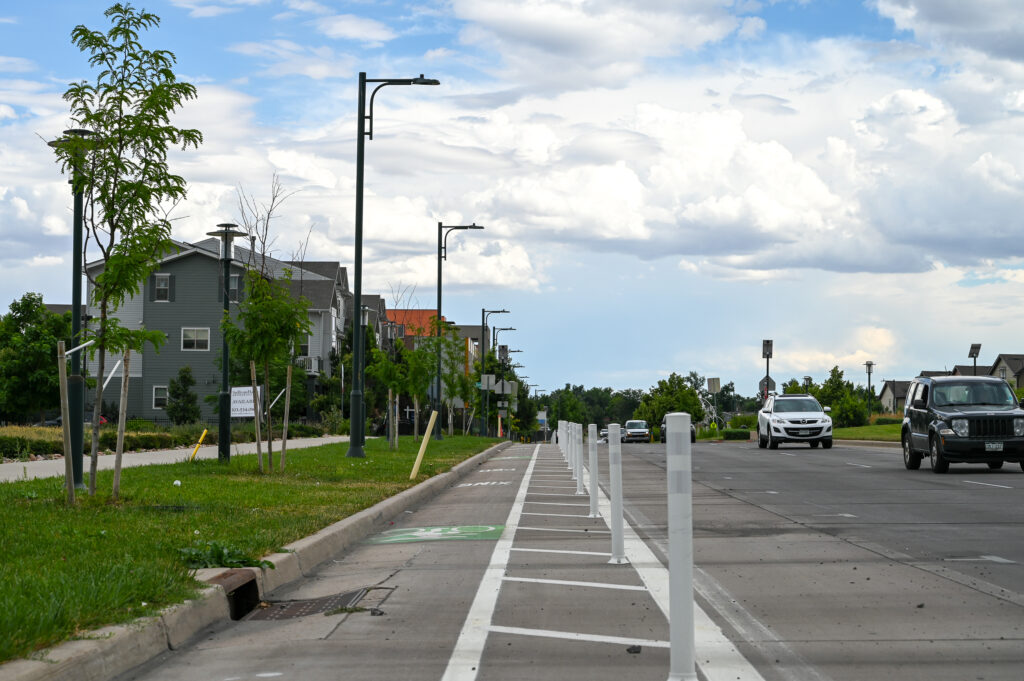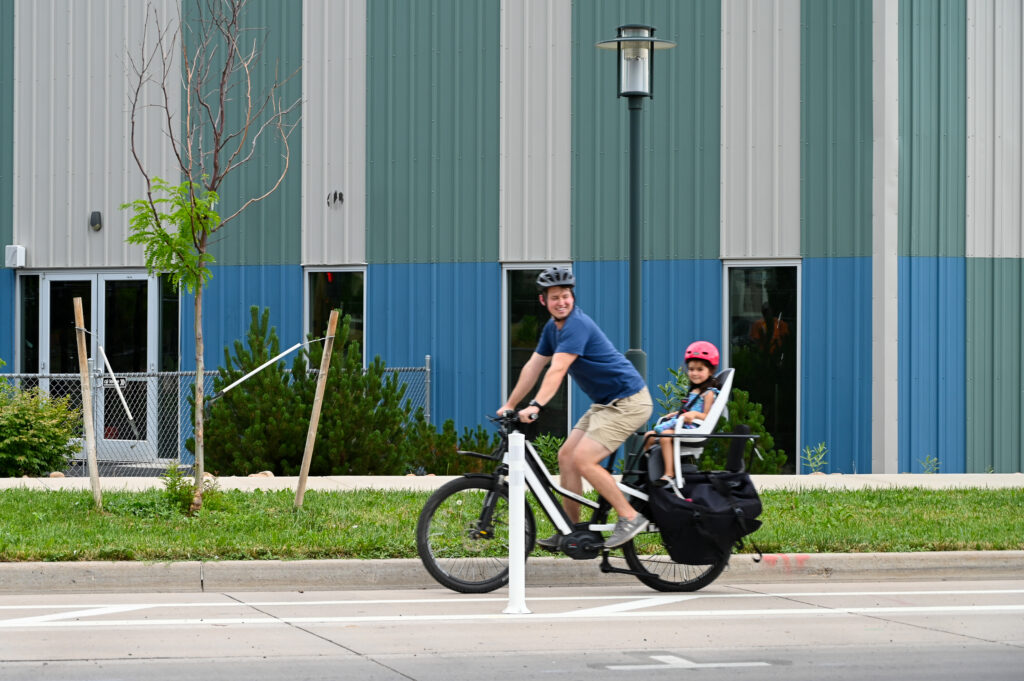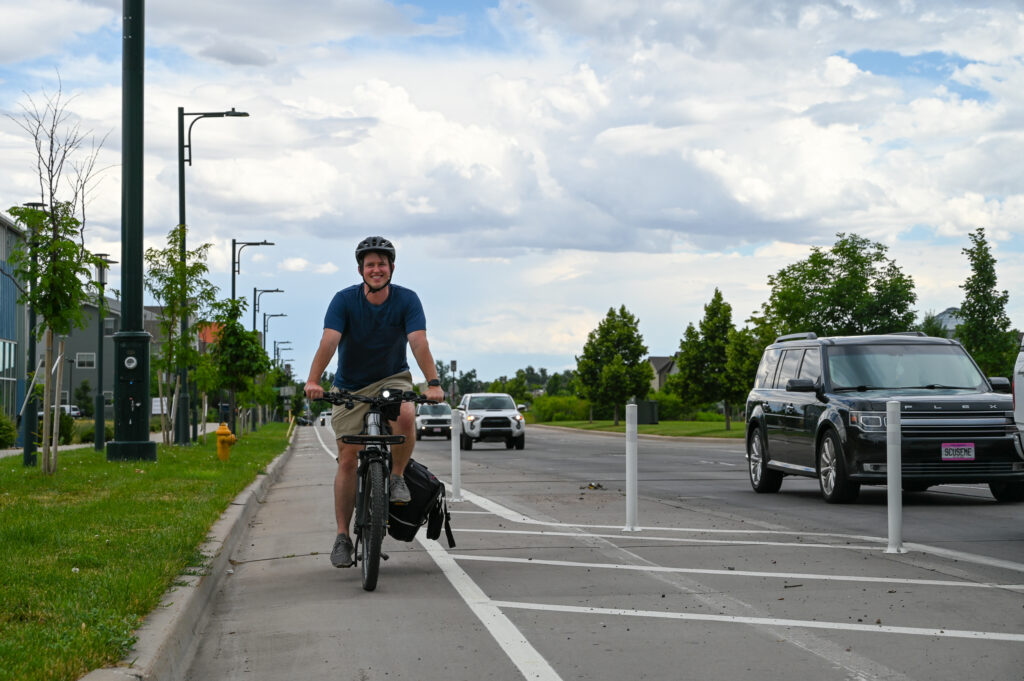By Brad Revare
As a Central Park dad, I commute seven miles to downtown to work by bike. I also ride with my toddler in search of playgrounds and ice cream on the weekends. When I bike alone or with my kid throughout Denver, I value the comfort and security of a separated and protected bike lane.

Recently, Denver’s Department of Transportation & Infrastructure (DOTI) completed the Central Park Boulevard (CPB) protected bike lane (PBL) in the Central Park neighborhood. Whether you value high-comfort biking, connectivity, pedestrian safety, or using street design to calm traffic, this project is a great start. However, there are key lessons and more work for the City to do overall, when it comes to bike lanes and fostering safety, community, and economic development.
Here’s what DOTI got right with this PBL:
- The value of high comfort biking: Swapping the bike and parking lanes so parked cars act as a barrier between bicyclists and drivers is better than an unprotected painted lane right next to drivers. Studies show PBLs result in fewer serious crashes and deaths for bicyclists AND drivers.
- The value of connectivity and usefulness: The PBL connects areas people want and need to access in our community, including:
- The Central Park light rail station and the affordable, transit-oriented housing built around it,
- Sprouts Farmers Market and the soon-to-open Natural Grocers for groceries,
- Our first neighborhood brewery, Flyte Brewing Co (soon to open at MLK and CPB),
- Central Park, a major park in the neighborhood,
- The Greenway, which is a fully separated path from the street that connects Fred Thomas Park to Stanley Marketplace and the wonderful Sand Creek Greenway.
- Finally, and most importantly, there are several DPS schools around Montview and CPB that are now more safely accessible by kids and parents.
- The value of pedestrian safety: The upgraded pedestrian infrastructure at many intersections and crosswalks along CPB is very welcome for parents and kids. They include “pork chops,” to encourage drivers to take safer right turns off of, and onto, CPB. Pedestrian bulb outs help make people crossing the street more visible, safer, and faster with a shorter distance to cross.
- The value of using street design to calm traffic: The redesign comes with narrower car lanes, which should help deter illegal speeding which is a constant safety issue in this area.
When you combine the location, length of the PBL, and the pedestrian safety features, it sure feels like a solution to many dangerous features of that street, so thank you DOTI! And thank you to community members who provided input and advocacy into its design over the years!
To truly live up to the sustainable aspirations and values of the Central Park neighborhood, more needs to be done to get people of all abilities using multimodal transportation on the trips we make in and around the neighborhood and Denver.
Here’s what we should all be working towards:
- Let’s connect neighborhoods and build community: I have no doubt that the volume of bicyclists using this PBL within Central Park will rise exponentially now that it is complete. But, what about all the other unprotected bike lanes, and unconnected communities, that intersect with it?
- Montview Blvd, 23rd Ave, MLK Blvd, and 35th Ave all have unprotected bike lanes (or have gaps in their bike lanes on certain stretches of the road) on very busy streets within Central Park. Let’s swap the bike lane and car parking on all these streets so East Colfax, Park Hill, and Central Park are more equitably, sustainably, and safely connected.
- Let’s build ample commercial bike parking so customers will follow (by bike): Generally speaking, most commercial spaces along CPB have very little mandated or voluntarily-installed bike parking. The City has a program that gives free and/or low cost bike parking racks to businesses that can be installed in the public right of way. Let’s make sure every business has the capacity to accommodate bike-riding customers.
- Make the area around the Central Park light rail station more multi-modal friendly so that more people can live, shop, work and access community space: The area around the Central Park light rail station is going to be a dense commercial and residential space right next to transit. Let’s work collaboratively to ensure this area becomes an inclusive, sustainable, and stress-free space for everyone to enjoy.
Whew, this is a lot! But the neighborhood is excited about the transformative effect of a protected bike lane on the busiest street in the neighborhood. Congratulations to DOTI on such a vital project. And yet, there’s so much more we can do to meet the neighborhood’s sustainability goals, connect to our surrounding neighborhoods, and help achieve the City’s Vision Zero goals by 2030.
Now if you’ll excuse me, my daughter and I are going to ride in search of ice cream.


Brad Revare is a Central Park dad who serves on the Board of Directors for the Central Park United Neighbors RNO, the Mayor’s Bicycle Advisory Committee, and the Mayor’s Pedestrian Advisory Committee.You can follow him on Twitter here: https://twitter.com/revarebrad
